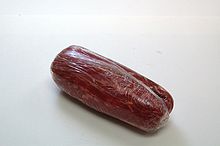- Transglutaminase
-
Transglutaminases are a family of enzymes (EC 2.3.2.13) that catalyze the formation of a covalent bond between a free amine group (e.g., protein- or peptide-bound lysine) and the gamma-carboxamid group of protein- or peptide-bound glutamine. Bonds formed by transglutaminase exhibit high resistance to proteolytic degradation.
Transglutaminases were first described in 1959.[1] The exact biochemical activity of transglutaminases was discovered in blood coagulation protein factor XIII in 1968.[2]
Contents
Physiological transglutaminases
Eight transglutaminases have been characterised.[3]
Name Gene Activity Chromosome OMIM Factor XIII (fibrin-stabilizing factor) F13A1, F13B coagulation 6p25-p24 134570 Keratinocyte transglutaminase TGM1 skin 14q11.2 190195 Tissue transglutaminase TGM2 ubiquitous 20q11.2-q12 190196 Epidermal transglutaminase TGM3 skin 20q12 600238 Prostate transglutaminase TGM4 prostate 3p22-p21.33 600585 TGM X TGM5[4] skin 15q15.2 603805 TGM Y TGM6 unclear 20q11-15 not assigned TGM Z TGM7 testis, lung 15q15.2 606776 Mechanism of action
Transglutaminases form extensively cross-linked, generally insoluble protein polymers. These biological polymers are indispensable for the organism to create barriers and stable structures. Examples are blood clots (coagulation factor XIII), as well as skin and hair.
The catalytic reaction is generally viewed as being irreversible, and must be closely monitored through extensive control mechanisms.[3] A collection of the transglutaminase substrate proteins and interaction partners is accessible in the TRANSDAB database.
Role in disease
Deficiency of factor XIII (a rare genetic condition) predisposes to hemorrhage; concentrated enzyme can be used to correct the abnormality and reduce bleeding risk.[3]
Antibodies to tissue transglutaminase are found in celiac disease and may play a role in the small bowel damage in response to dietary gliadin that characterises this condition.[3] In the related condition dermatitis herpetiformis, in which small bowel changes are often found and which responds to dietary exclusion of gliadin-containing wheat products, epidermal transglutaminase is the predominant autoantigen.[5]
Recent research indicates that sufferers from neurological diseases like Huntington's,[6] and Parkinson's[7] may have unusually high levels of one type of transglutaminase, tissue transglutaminase. It is hypothesized that tissue transglutaminase may be involved in the formation of the protein aggregates that causes Huntington's disease, although it is most likely not required.[3][8]
Mutations in keratinocyte transglutaminase are implicated in lamellar ichthyosis.
Industrial and culinary applications
In commercial food processing, transglutaminase is used to bond proteins together. Examples of foods made using transglutaminase include imitation crabmeat, and fish balls. It is produced by Streptoverticillium mobaraense fermentation in commercial quantities or extracted from animal blood,[9] and is used in a variety of processes, including the production of processed meat and fish products.
Transglutaminase can be used as a binding agent to improve the texture of protein-rich foods such as surimi or ham.[10]
Transglutaminase can be used in these applications:[citation needed]
- Improving texture of emulsified meat products, such as sausages and hot dogs.
- Binding different meat parts into a larger ones ("portion control"), such as in restructured steaks. Transglutaminase is one of several forms of "meat glue".
- Improving the texture of low-grade meat such as so-called "PSE meat" (pale, soft, and exudative meat, whose characteristics are attributed to stress and a rapid postmortem pH decline)
- Making milk and yogurt creamier
- Making noodles firmer
Molecular gastronomy
Transglutaminase is also used in molecular gastronomy to meld new textures with existing tastes. Besides these mainstream uses, transglutaminase has been used to create some unusual foods. British chef Heston Blumenthal is credited with the introduction of transglutaminase into modern cooking.
Wylie Dufresne, chef of New York's avant-garde restaurant wd~50, was introduced to transglutaminase by Blumenthal, and invented a "pasta" made from over 95% shrimp thanks to transglutaminase.[11]
See also
References
- ^ Clarke DD, Mycek MJ, Neidle A, Waelsch H (1959). "The incorporation of amines into proteins". Arch Biochem Biophys 79: 338–354. doi:10.1016/0003-9861(59)90413-8.
- ^ Pisano JJ, Finlayson JS, Peyton MP (1968). "[Cross-link in fibrin polymerized by factor 13: epsilon-(gamma-glutamyl)lysine.]". Science 160 (3830): 892–3. doi:10.1126/science.160.3830.892. PMID 4967475.
- ^ a b c d e Griffin M, Casadio R, Bergamini CM (2002). "Transglutaminases: nature's biological glues". Biochem J 368 (Pt 2): 377–96. doi:10.1042/BJ20021234. PMC 1223021. PMID 12366374. http://www.biochemj.org/bj/368/0377/bj3680377.htm. Full text at PMC: 1223021
- ^ Aeschlimann D, Koeller MK, Allen-Hoffmann BL, Mosher DF (1998). "Isolation of a cDNA encoding a novel member of the transglutaminase gene family from human keratinocytes. Detection and identification of transglutaminase gene products based on reverse transcription-polymerase chain reaction with degenerate primers". J. Biol. Chem. 273 (6): 3452–60. doi:10.1074/jbc.273.6.3452. PMID 9452468. http://www.jbc.org/cgi/content/full/273/6/3452.
- ^ Sárdy M, Kárpáti S, Merkl B, Paulsson M, Smyth N (March 2002). "Epidermal transglutaminase (TGase 3) is the autoantigen of dermatitis herpetiformis". J. Exp. Med. 195 (6): 747–57. doi:10.1084/jem.20011299. PMC 2193738. PMID 11901200. http://www.jem.org/cgi/content/full/195/6/747.
- ^ Karpuj MV, Becher MW, Steinman L (2002). "Evidence for a role for transglutaminase in Huntington's disease and the potential therapeutic implications". Neurochem. Int. 40 (1): 31–6. doi:10.1016/S0197-0186(01)00060-2. PMID 11738470.
- ^ Vermes I, Steur EN, Jirikowski GF, Haanen C (2004). "Elevated concentration of cerebrospinal fluid tissue transglutaminase in Parkinson's disease indicating apoptosis". Mov. Disord. 19 (10): 1252–4. doi:10.1002/mds.20197. PMID 15368613.
- ^ Lesort M, Chun W, Tucholski J, Johnson GV (2002). "Does tissue transglutaminase play a role in Huntington's disease?". Neurochem. Int. 40 (1): 37–52. doi:10.1016/S0197-0186(01)00059-6. PMID 11738471.
- ^ Köhler, Wim (2008-08-22). "Gelijmde slavink" (in Dutch). NRC Handelsblad. http://www.nrc.nl/achtergrond/article1960242.ece/Gelijmde_slavink. Retrieved 2009-03-05.
- ^ Yokoyama K, Nio N, Kikuchi Y (2004). "Properties and applications of microbial transglutaminase". Appl. Microbiol. Biotechnol. 64 (4): 447–54. doi:10.1007/s00253-003-1539-5. PMID 14740191.
- ^ Jon, Bonné (2005-02-11). "Noodles, reinvented". MSNBC.com. http://www.msnbc.msn.com/id/6915287/. Retrieved 2008-04-02.
External links
Categories:- EC 2.3.2
- Food additives
- Autoantigens
Wikimedia Foundation. 2010.

